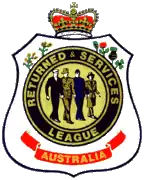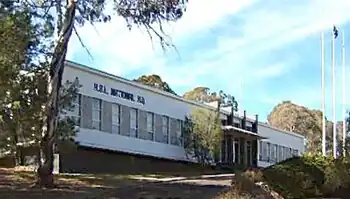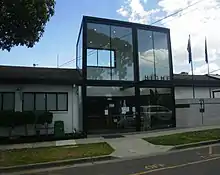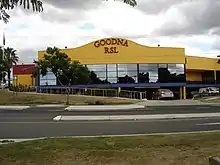Returned and Services League of Australia
The Returned and Services League of Australia (RSL) is a support organisation for people who have served or are serving in the Australian Defence Force.
 | |
| Abbreviation | RSL |
|---|---|
| Formation | 1916 |
| Type | Ex-service organisation |
| Registration no. | ACN 008 488 097 |
| Legal status | Charity |
Membership (2019) | 158,873 |
Patron | King Charles III |
National President | Greg Melick |
| Affiliations | Royal Commonwealth Ex-Services League (RCEL) |
| Website | www |
Formerly called | 1916: Returned Sailors and Soldiers Imperial League of Australia 1940: Returned Sailors', Soldiers' and Airmen's Imperial League of Australia 1965: Returned Services League of Australia (to 1990) |
Mission
The RSL's mission is to ensure that programs are in place for the well-being, care, compensation and commemoration of serving and ex-service Defence Force members and their dependants;[1][2][3][4] and promote Government and community awareness of the need for a secure, stable and progressive Australia.[5] However, even as late as the 1970s it was described as an "inherently conservative" organisation.[6]
History

The League evolved out of concern for the welfare of returned servicemen from the First World War. In 1916, a conference at which representatives from Queensland, South Australia, Tasmania and Victoria were present recommended the formation of The Returned Sailors and Soldiers Imperial League of Australia (RSSILA). New South Wales was admitted to the League the following year and Western Australia in 1918. In 1927, the Australian Capital Territory formed a branch and was admitted. During the inter-war period 1919 to 1939, the RSSILA was recognised as the appropriate body to represent the interests of returned Australian service personnel in exchange for extending political cooperation to the Nationalist Party of Prime Minister Stanley Bruce. The RSSILA was noted for its right-wing politics, in 1919 drawing on its membership to form a 2,000-strong paramilitary force called the "Army to fight Bolshevism", and permitting various right-wing Australian militia groups access to its membership lists to convince returned servicemen to join them.[7] In 1948, WW1 veteran and politician Fred Paterson was expelled from the organisation for being a communist.[8]
In 1940, the name of the League changed to the Returned Sailors', Soldiers' and Airmen's Imperial League of Australia (RSSAILA). It changed again in 1965, to the Returned Services League of Australia (RSL). Two more name changes occurred: in 1983, to the Returned Services League of Australia (RSL) and in 1990, to the Returned & Services League of Australia Limited (RSL), a company limited by guarantee.[9] The objects of the League remain relatively unchanged from its first incorporation. After the Second World War, amidst widespread antisemitism in Australia, the Returned Service League published antisemitic political cartoons encouraging the Australian government and Minister for Immigration Arthur Calwell to stem the flow of Jewish immigrants fleeing postwar violence.[10]
RSL badge symbolism
At the top of the badge is a crown, signifying allegiance to the Crown. Below the crown are the national flowers of Australia, Wales, England, Scotland and Ireland: the wattle, leek, rose, thistle, and shamrock. In the centre of the badge are a sailor, soldier, airman and service woman marching with their arms linked, symbolising friendship and the unity of all services and all ranks in comradeship. The red of the badge symbolises the blood ties of war. The white background stands for the purity of motive and the rendering of service without personal gain. The blue is a symbol of willingness to render service to a comrade anywhere under the sky.[9]
The badge may only be worn by members of the League: it is an offence under the laws of most Australian states and territories for an individual to wear an RSL badge (a) that has not been issued specifically to them by the RSL, and (b) unless they are entitled to wear the badge, at that time, under the rules of the League.[note 1]
Influence
The influence of the League derives from its founding days organising rituals for ANZAC Day dawn services and marches, and Remembrance Day commemorations. However, even as early as the 1920s, the role of the League became controversial as some leagues banned women from attending the dawn service because of 'excessive wailing'.[11] In addition to pressing for benefits for veterans, the organisation entered other areas of political debate. The RSL was politically conservative,[12][13] Anglophilic, and monarchist.[14]
In the 1970s and 1980s, many defence force personnel, including veterans of the Vietnam War, found the RSL – whose members had predominantly served in the Second World War – generally unwelcoming and disdaining of their service.[15] Since the turn of the century, with the number of Second World War veterans in the RSL dwindling, Vietnam veterans and their contemporaries, along with ex-servicemen's wives, have become mainstays of the League.[1]
The focus of the RSL has been on the welfare of Australian men and women who have served in the armed forces. It has advocated for veterans' entitlements and the protection of former battlefields. Usually RSL members ensure that those who have served their country are commemorated by notifying funeral information and handing out poppies at the funeral.[16]
Organisation

The League is overseen by a National Executive that consists of the National President; the Deputy National President; State Branch Presidents for New South Wales, Victoria, the Australian Capital Territory, Queensland, South Australia, Tasmania, and Western Australia; and the National Chief Executive Officer (CEO), the National Treasurer, the National Legal Adviser, the National Defence Adviser, and the Veterans' Affairs Adviser.[17]

The National CEO has operational control of the National Office. In 2015 the National Office building, on Constitution Avenue, Campbell, in Canberra, was demolished. The site became a large apartment block, in which the office was located as of 2019.
In each state and territory has a branch of the League, with a similar hierarchical structure. Within each branch is a series of districts and sub-branches that serve the interests of members in a particular geographic area.[18][19]
The naming of these branches and sub-branches should not be confused with the commercial entities generally called RSL Clubs. Ownership and operation of RSL and Services clubs differ from state to state. For example, RSL NSW and its sub-Branches do not own or operate any registered clubs, nor do they own or operate poker machines however RSL Victoria sub-Branches do. [18]
| National presidents | ||||
|---|---|---|---|---|
| Order | Rank | Name | Postnominals | Held office |
| 1 | Brigadier General | William Kinsey Bolton | CBE, VD | 1916–1919 |
| 2 | Captain | Sir Gilbert Dyett | CMG | 1919–1946 |
| 3 | Colonel | Sir Eric Millhouse[20] | KC | 1946–1950 |
| 4 | Sergeant | Sir George Holland | CBE, MM | 1950–1960 |
| 5 | Lieutenant Colonel | Sir Arthur Lee | KBE, MC & Bar | 1960–1974 |
| 6 | Brigadier | Sir William Hall | KBE, DSO, ED | 1974–1978 |
| 7 | Captain | Sir William Keys | AC, OBE, MC | 1978–1988 |
| 8 | Brigadier | Alf Garland | AM | 1988–1993 |
| 9 | Major General | Digger James | AC, MBE, MC | 1993–1997 |
| 10 | Major General | Peter Phillips | AO, MC | 1997–2003 |
| 11 | Major General | Bill Crews | AO | 2003–2009 |
| 12 | Rear Admiral | Ken Doolan | AO, RAN | 2009–2016 |
| 13 | Major | Rod White | AM, RFD | 2016–2017 |
| 14 | Warrant Officer | Robert Dick | 2017–2018 | |
| 15 | Major General | Greg Melick | AO, RFD, SC | 2019–present |
Controversy involving RSL New South Wales councillors
On 4 October 2016, the Sydney Morning Herald and ABC News reported that RSL national president Rod White, a retired major of the Australian Army Reserve, received a share in nearly $1 million of consulting fees paid by an arm of the League, RSL LifeCare, and failed to disclose conflicts of interest.[21] Mr White denied any wrongdoing and was quoted as saying, when questioned by an ABC News reporter: "I believe I have personally fulfilled my obligations legally and ethically and I'm just absolutely surprised at your questioning of my integrity in that regard".[22]
In October 2016, legal advice commissioned by the RSL's New South Wales Branch indicated RSL New South Wales councillors, including Mr White, may have broken the law by receiving a share in $1 million of consulting fees while holding a voluntary position in the veteran's group: "It is possible, but not certain, that in doing so they did not meet one or more of their duties and obligations, or contravened the law."[23] Subsequently, calls were made for Mr White to step aside in order to rebuild public trust in the League.[24][25][26]
On 7 November 2016, ABC News reported Mr White as being likely to stand down pending an investigation into the consultancy fee payments, and that new documents obtained by ABC revealed that the quantum of consultancy fees paid was "far greater than originally thought – totalling more than $2 million since 2007".[27]
On Remembrance Day 2016, ABC News reported that the New South Wales Branch of the RSL was at risk of losing its charity status as a result of the payment scandal and that the Australian Charities and Not-For-Profits Commission had written to the RSL "outlining its concerns that the league may not be meeting its obligations as a charity" and warning, as a worst case, that "the commission may use its powers to revoke the league's charity status if it finds evidence that the rules have been broken".[28][29]
The RSL acting national president, Robert Dick, was subsequently reported as saying the league would be working with "regulatory bodies to deliver an appropriate corporate governance structure to ensure there is no maladministration in the NSW Branch. We are determined to expose any wrongdoing".[30]
In March 2017, Mr White resigned as President of the RSL; he had held the position for eight months.[31]
Licensed clubs

Licensed clubs were formed as commercial activities to initially provide services by sub-branches to their members, including providing an environment for the protection and promotion of the ideals of the ANZAC spirit and heritage. The venues were established to provide hospitality for war veterans and a place for comradeship. Often they were located on land granted by the state government.[32] Over time these commercial entities, known generally as RSL Clubs (but also called Ex-Services, Memorial, Legion or other similar names)[32] generated profits and often donated to local community services.[18][32]
The membership base of the licensed clubs, totalling more than a million, differs significantly from membership of the Returned and Services League (RSL). Membership of the League does not automatically confer rights of entry or membership to a licensed club but in some jurisdictions clubs extend honorary membership to serving members of the ADF.[32][33]

Licensed clubs operating under the RSL name usually have bar and dining facilities for their members and guests, and sometimes have extensive gambling areas. Each evening at 6.00 pm the Ode of Remembrance is read, followed by one minute's silence to honour those who died serving their country.[34]
RSL NSW and its sub-Branches do not own or operate any registered clubs, nor do they own or operate poker machines.
Other commercial activities
RSL Care
The first RSL home for ex-servicemen was established in 1938. The affiliated organisation, which became RSL Care, had 26 facilities in 2011. Following a merger with the Royal District Nursing Service in Victoria, in 2016 it became RSL Care RDNS Limited, an Australian public company registered as a charity, trading as Bolton Clarke. With more than 28 retirement communities throughout Queensland and New South Wales and several others in development, it was one of Australia's largest providers of retirement living and aged care services.[35][36]
RSL Cabs
Operating under a co-operative structure, in 1946 a group of returned servicemen established RSL Ex-Servicemen's Cabs & Co-Operative Members Limited to provide taxi services to Sydney. By the 1950s, the co-operative had expanded to more than 60 drivers.[37] As of 2021 it operated on a commercial basis in which drivers were not required to be members of the League.
RSL Art Union
Commenced in Queensland in 1956, the RSL Art Union is a lottery that raises funds to provide welfare services to ex-service men and women, their dependents and to other members of the community. A major prize of a luxury waterfront home on Queensland's Gold Coast is usually offered, together with a range of bonus prizes. As of 2011, the RSL Art Union had provided since its inception A$80 million in prizes and had raised more than A$70 million for development and maintenance of RSL nursing homes, hospitals and centres, and retirement complexes for elderly people.[38]
Notes
- See, for example, the Returned Servicemen's Badges Act 1952 (SA), the Returned Servicemen's Badges Act 1953 (WA), the Returned Servicemen's Badges Act 1955 (Tas), the Returned Servicemen's Badges Act 1956 (Qld), the Returned Servicemen's Badges Act 1956 (Vic), the Returned Servicemen's Badges Act 1960 (ACT), and the Discharged Servicemen's Badges Act 1964 (NSW).
See also
- Similar veterans' organisations
References
- "About Us • RSL National". RSL National. Retrieved 28 June 2021.
- "Services". RSL ACT Branch. Retrieved 28 June 2021.
- "Mission Statement « RSL Tasmania". Retrieved 28 June 2021.
- "Visions & Missions". RSLWA. Retrieved 28 June 2021.
- "Our Objectives « RSL Tasmania". Retrieved 28 June 2021.
- Blaxland, John (2016). The protest years: the official history of ASIO, 1963-1975. Crows Nest, NSW: Allen & Unwin. p. 115. ISBN 9781760294182.
- Moore, Andrew (1995). The Right Road? A History of Right-wing Politics in Australia. Melbourne: Oxford University Press, Australia. p. 25. ISBN 0-19-553512-X.
- "Paterson expelled by Q'ld RSL council without a hearing". The Northern Standard. Darwin, NT: National Library of Australia. 28 May 1948. p. 8. Retrieved 14 February 2014.
- "RSL Badge Symbolism". History. Returned and Services League of Australia (Victorian Branch). Archived from the original on 31 December 2012. Retrieved 2 June 2011.
- Gollan, [by] Robin (1975). Revolutionaries and reformists : Communism and the Australian Labour Movement, 1920-1955. Canberra: Australian National University Press. pp. 158–161. ISBN 0708102506.
- Kemp, Miles (22 April 2013). "Women war veterans keep Australian Air Force flag flying". Adelaidenow.com.au. Retrieved 17 February 2023.
- Crotty, Martin (2 January 2019). "'What more do you want?': Billy Hughes and Gilbert Dyett in late 1919". History Australia. 16 (1): 52–71. doi:10.1080/14490854.2018.1558069. ISSN 1449-0854. S2CID 150593843.
- Crotty, Martin (1 June 2007). "The Anzac Citizen: Towards a History of the RSL". Australian Journal of Politics & History. 53 (2): 183–193. doi:10.1111/j.1467-8497.2007.00453.x. ISSN 0004-9522.
- Kullmann, Claudio (5 November 2008). "Attitudes towards the Monarchy in Australia and New Zealand Compared". Commonwealth & Comparative Politics. 46 (4): 442–463. doi:10.1080/14662040802461125. ISSN 1466-2043. S2CID 144715921.
- Ryan, Kel (January 2013). "The changing nature of Australian ex-service organisations". Third Sector Review. 19: 27–49. eISSN 1323-9163 – via Informit.
- "RSL Funeral Ritual – Morwell RSL". Retrieved 17 February 2023.
- "2009 RSL Annual Report" (PDF). About the RSL – Annual Reports. Returned and Services League of Australia. 2009. pp. 70–71. Archived from the original (PDF) on 16 March 2012. Retrieved 30 May 2011.
- "Returned & Services League of Australia (Victorian Branch) Inc". Productivity Commission Issues Paper. Productivity Commission. March 2009. p. 4. Archived from the original on 2 April 2015. Retrieved 30 May 2011.
- "What is the RSL?". About us. Returned and Services League of Australia (Queensland Branch). 2010. Archived from the original on 3 September 2011. Retrieved 30 May 2011.
- Death of Sir Eric Millhouse, The Age, (Monday, 27 February 1950), p.2; Archived 21 October 2017 at the Wayback Machine Many Tributes to Sir Eric Millhouse, The (Adelaide) Advertiser, Monday, 27 February 1950, p.3. Archived 21 October 2017 at the Wayback Machine
- "RSL volunteers share in hundreds of thousands of dollars as consulting fees". David Wroe. Sydney Morning Herald. 4 October 2016. Archived from the original on 11 November 2016. Retrieved 10 November 2016.
- "Federal RSL president Rod White defends receiving tens of thousands of dollars from within organisation". Angela Lavoipierre. ABC News. 4 October 2016. Archived from the original on 9 November 2016. Retrieved 10 November 2016.
- "Legal advice thinks RSL bosses may have broken the law". David Wroe. Sydney Morning Herald. 21 October 2016. Archived from the original on 26 October 2016. Retrieved 10 November 2016.
- Angela Lavoipierre (8 October 2016). "RSL president Rod White faces internal anger over payments received". ABC News. Australian Broadcasting Corporation. Archived from the original on 7 October 2017. Retrieved 10 November 2016.
- "RSL president must step aside to rebuild public trust". Sydney Morning Herald. Archived from the original on 7 October 2017. Retrieved 10 November 2016.
- "Only strong leadership can save the RSL". Sydney Morning Herald. 19 January 2017. Archived from the original on 7 October 2017. Retrieved 8 October 2017.
- "RSL president Rod White agrees to stand down amid claims of receiving and failing to disclose payments". Angela Lavoipierre. ABC News. 7 November 2016. Archived from the original on 10 November 2016. Retrieved 10 November 2016.
- "RSL NSW risks losing charity status in wake of payments scandal". Angela Lavoipierre. ABC News. 10 November 2016. Archived from the original on 11 November 2016. Retrieved 11 November 2016.
- "RSL NSW 'ruined' if charity status revoked". Gemma Najem and Rebecca Chirichiello of the Australian Associated Press. The Weekend Australian. Retrieved 12 November 2016.
- "NSW govt to be briefed on RSL misconduct". Australian Associated Press. NT News. Retrieved 30 November 2016.
- "RSL national president Rod White resigns amid investigation into alleged financial scandal". Angela Lavoipierre. ABC News. 9 March 2017. Archived from the original on 10 March 2017. Retrieved 10 March 2017.
- "Letter from the RSL & Services Clubs Association Limited responding to the Discussion Paper re a New Framework for Consultation with the Ex-Service and Defence Communities" (PDF). Prime Ministerial Advisory Council on Ex-Service Matters. Department of Veterans' Affairs. 24 April 2008. p. 2. Archived from the original (PDF) on 1 June 2011. Retrieved 31 May 2011.
- Christiansen, Melanie (1 February 2008). "RSL clubs fight for future". The Courier-Mail. News Limited. Archived from the original on 15 September 2012. Retrieved 31 May 2011.
- "Words of Remembrance". ANZAC Day. ANZAC Day Commemoration Committee (Qld) Incorporated. 1998. Archived from the original on 3 June 2011. Retrieved 31 May 2011.
- "History". RSL Care. RSL (Qld) War Veterans' Homes Limited. 2010. Archived from the original on 6 May 2011. Retrieved 30 May 2011.
- "Historical details for ABN 90 010 488 454". ABN Lookup. Australian Business Register. 2021. Retrieved 4 May 2021.
- "Home". RSL Cabs. RSL Ex-Servicemen's Cabs & Co-Operative Members Limited. Archived from the original on 18 February 2011. Retrieved 30 May 2011.
- "Who is the RSL". RSL Art Union. RSL Art Union. 2010. Archived from the original on 4 July 2011. Retrieved 30 May 2011.
External links
- RSL Australian Capital Territory website
- RSL New South Wales website
- RSL Queensland website
- RSL South Australia website
- RSL Tasmania website
- RSL Victoria website
- RSL Western Australia website
- Among Mates – Culture Victoria video on the role and history of the RSL in Victoria and the foundation of the Caulfield branch.
- RSL Art Union
- RSL Angeles City Sub Branch Philippines
- In Flanders Field
- Poppies